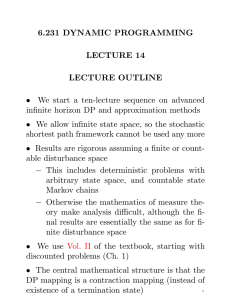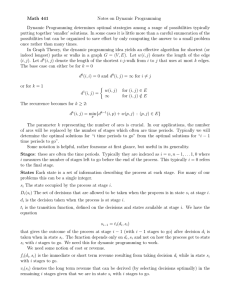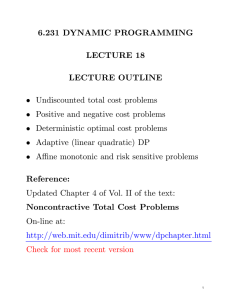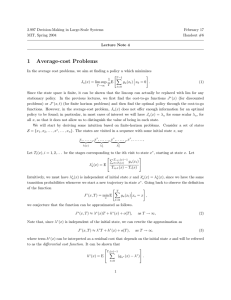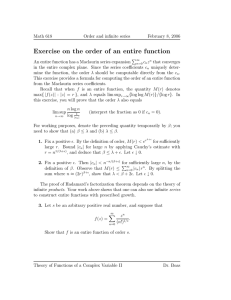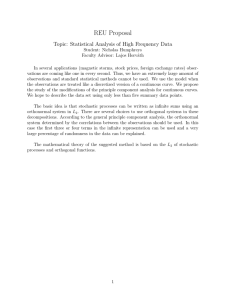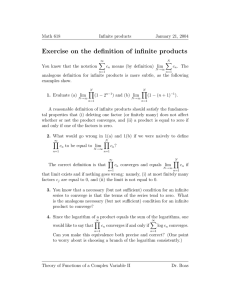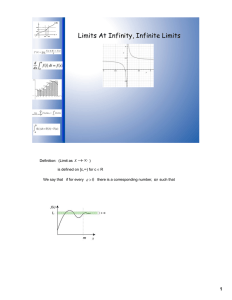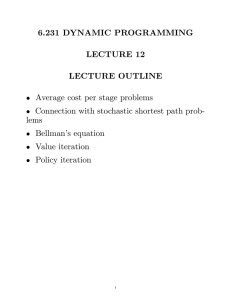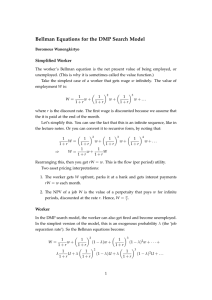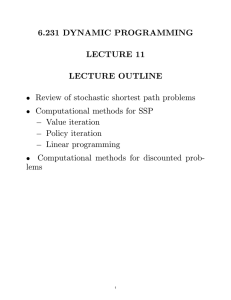6.231 DYNAMIC PROGRAMMING LECTURE 10 LECTURE OUTLINE Infinite horizon problems
advertisement
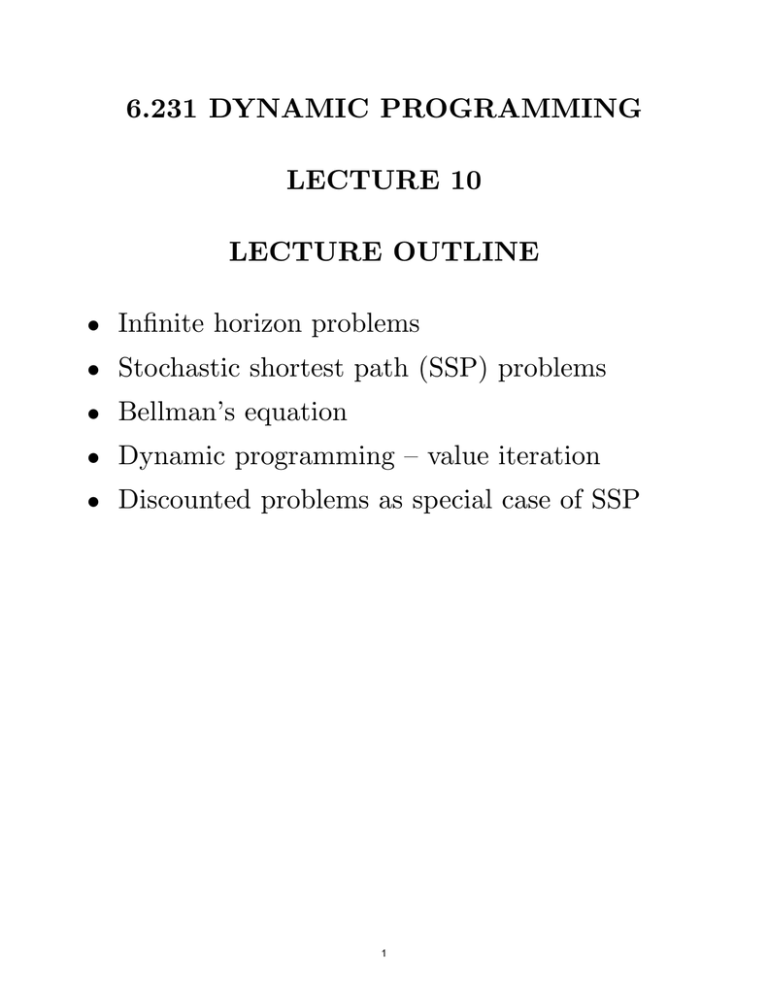
6.231 DYNAMIC PROGRAMMING
LECTURE 10
LECTURE OUTLINE
• Infinite horizon problems
• Stochastic shortest path (SSP) problems
• Bellman’s equation
• Dynamic programming – value iteration
• Discounted problems as special case of SSP
1
TYPES OF INFINITE HORIZON PROBLEMS
• Same as the basic problem, but:
− The number of stages is infinite.
− Stationary system and cost (except for dis-
counting).
• Total cost problems: Minimize
Jπ (x0 ) = lim
N →∞
E
w
k
k=0,1,...
(N −1
X
αk g xk , µk (xk ), wk
k=0
)
(if the lim exists - otherwise lim sup).
− Stochastic shortest path (SSP) problems (α =
1, and a termination state)
− Discounted problems (α < 1, bounded g )
− Undiscounted, and discounted problems with
unbounded g
• Average cost problems
lim
N →∞
1
N
E
wk
k=0,1,...
(N −1
X
k=0
g xk , µk (xk ), wk
)
• Infinite horizon characteristics: Challenging anal-
ysis, elegance of solutions and algorithms (stationary optimal policies are likely)
2
PREVIEW OF INFINITE HORIZON RESULTS
• Key issue: The relation between the infinite and
finite horizon optimal cost-to-go functions.
• For example, let α = 1 and JN (x) denote the
optimal cost of the N -stage problem, generated
after N DP iterations, starting from some J0
Jk+1 (x) = min E g(x, u, w) + Jk f (x, u, w)
u∈U (x) w
• Typical results for total cost problems:
, ∀x
− Convergence of value iteration to J ∗ :
J ∗ (x) = min Jπ (x) = lim JN (x),
∀x
N →∞
π
− Bellman’s equation holds for all x:
∗
J (x) = min E g(x, u, w) + J
u∈U (x) w
∗
f (x, u, w)
− Optimality condition: If µ(x) minimizes in
Bellman’s Eq., {µ, µ, . . .} is optimal.
• Bellman’s Eq. holds for all deterministic prob-
lems and “almost all” stochastic problems.
Other results: True for SSP and discounted;
exceptions for other problems.
•
3
“EASY” AND “DIFFICULT” PROBLEMS
• Easy problems (Chapter 7, Vol. I of text)
− All of them are finite-state, finite-control
− Bellman’s equation has unique solution
− Optimal policies obtained from Bellman Eq.
− Value and policy iteration algorithms apply
• Somewhat complicated problems
− Infinite state, discounted, bounded g (con-
tractive structure)
− Finite-state SSP with “nearly” contractive
structure
− Bellman’s equation has unique solution, value
and policy iteration work
• Difficult problems (w/ additional structure)
− Infinite state, g ≥ 0 or g ≤ 0 (for all x, u, w)
− Infinite state deterministic problems
− SSP without contractive structure
• Hugely large and/or model-free problems
− Big state space and/or simulation model
− Approximate DP methods
• Measure theoretic formulations (not in this course)
4
STOCHASTIC SHORTEST PATH PROBLEMS
• Assume finite-state system: States 1, . . . , n and
special cost-free termination state t
− Transition probabilities pij (u)
− Control constraints u ∈ U (i) (finite set)
− Cost of policy π = {µ0 , µ1 , . . .} is
Jπ (i) = lim E
N →∞
(N −1
X
k=0
g xk , µk (xk ) x0 = i
)
− Optimal policy if Jπ (i) = J ∗ (i) for all i.
− Special notation: For stationary policies π =
{µ, µ, . . .}, we use Jµ (i) in place of Jπ (i).
• Assumption (termination inevitable): There exists integer m such that for all policies π :
ρπ = max P {xm 6= t | x0 = i, π} < 1
i=1,...,n
• Note: We have ρ = maxπ ρπ < 1, since ρπ depends only on the first m components of π .
• Shortest path examples: Acyclic (assumption is
satisfied); nonacyclic (assumption is not satisfied)
5
FINITENESS OF POLICY COST FUNCTIONS
• View
ρ = max ρπ < 1
π
as an upper bound on the non-termination prob.
during 1st m steps, regardless of policy used
• For any π and any initial state i
P {x2m 6= t | x0 = i, π} = P {x2m 6= t | xm 6= t, x0 = i, π}
× P {xm 6= t | x0 = i, π} ≤ ρ2
and similarly
P {xkm =
6 t | x0 = i, π} ≤ ρk ,
i = 1, . . . , n
• So E{Cost between times km and (k + 1)m − 1 }
≤ mρ
and
k
max g(i, u)
i=1,...,n
u∈U (i)
∞
X
k
Jπ (i) ≤
mρ max g(i, u) =
k=0
i=1,...,n
u∈U (i)
6
m
1−ρ
max g(i, u)
i=1,...,n
u∈U (i)
MAIN RESULT
• Given any initial conditions J0 (1), . . . , J0 (n), the
sequence Jk (i) generated by value iteration,
Jk+1 (i) = min
u∈U (i)
"
#
n
g(i, u) +
X
pij (u)Jk (j) , ∀ i
j=1
converges to the optimal cost J ∗ (i) for each i.
• Bellman’s equation has J ∗ (i) as unique solution:
∗
J (i) = min
u∈U (i)
"
#
n
g(i, u) +
X
pij (u)J ∗ (j) , ∀ i
j=1
J ∗ (t) = 0
A stationary policy µ is optimal if and only
if for every state i, µ(i) attains the minimum in
Bellman’s equation.
•
• Key proof idea: The “tail” of the cost series,
∞
X
k=mK
E g xk , µk (xk )
vanishes as K increases to ∞.
7
OUTLINE OF PROOF THAT JN → J ∗
• Assume for simplicity that J0 (i) = 0 for all i.
For any K ≥ 1, write the cost of any policy π as
mK−1
Jπ (x0 ) =
X
+
mK−1
X
+
k=0
≤
k=0
E g xk , µk (xk )
E g xk , µk (xk )
∞
X
k=mK
∞
X
E g xk , µk (xk )
ρk m max |g(i, u)|
i,u
k=K
Take the minimum of both sides over π to obtain
ρK
J (x0 ) ≤ JmK (x0 ) +
m max |g(i, u)|.
i,u
1−ρ
∗
Similarly, we have
ρK
JmK (x0 ) −
m max |g(i, u)| ≤ J ∗ (x0 ).
i,u
1−ρ
It follows that limK→∞ JmK (x0 ) = J ∗ (x0 ).
• JmK (x0 ) and JmK+k (x0 ) converge to the same
limit for k < m (since k extra steps far into the
future don’t matter), so JN (x0 ) → J ∗ (x0 ).
• Similarly, J0 =
6 0 does not matter.
8
EXAMPLE
• Minimizing the E{Time to Termination}: Let
g(i, u) = 1,
∀ i = 1, . . . , n, u ∈ U (i)
• Under our assumptions, the costs J ∗ (i) uniquely
solve Bellman’s equation, which has the form
∗
J (i) = min
u∈U (i)
"
#
n
1+
X
pij (u)J ∗ (j) ,
j=1
i = 1, . . . , n
• In the special case where there is only one control at each state, J ∗ (i) is the mean first passage
time from i to t. These times, denoted mi , are the
unique solution of the classical equations
mi = 1 +
n
X
pij mj ,
i = 1, . . . , n,
j=1
which are seen to be a form of Bellman’s equation
9
MIT OpenCourseWare
http://ocw.mit.edu
6.231 Dynamic Programming and Stochastic Control
Fall 2015
For information about citing these materials or our Terms of Use, visit: http://ocw.mit.edu/terms.
